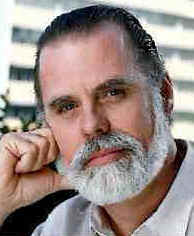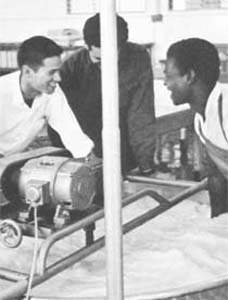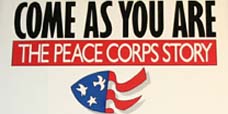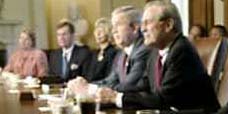
Wanda Sabir had the opportunity to speak to Taylor Hackford, director of the film “Ray” last year after a preview screening.
'Ray’ director Taylor Hackford
Interviewed by Wanda Sabir
Actor Jamie Foxx and his daughter Corrine pose with his Oscar at the Governor's Ball following the 77th annual Academy Awards Sunday night.
Photo: Lucy Nicholson, Reuters
The Oscars were a major coup for African Americans in film this year. Nominations for Don Cheadle and Sophie Okonedo for “Hotel Rwanda,” Morgan Freeman for “Million Dollar Baby” and of course Jamie Foxx for two films, “Ray” and “Collateral Damage,” were just a few of the many reasons why one could say, Hollywood has come a long way from the Denzel Washington, Halle Berry, Sidney Poitier awards a few years ago.
Chris Rocks’ stunning job as emcee of the 77th annual event was another reason to watch the show, a happy occasion in many Black homes last weekend even though once again the Black cast walked away with only two Oscars – Foxx for best actor in “Ray” and Freeman for best supporting actor in “Million Dollar Baby.”
I had the opportunity to speak to Taylor Hackford, director of the film “Ray” last year after a preview screening. “Ray” sets a new trend in Black cinematic storytelling, one we see reflected in the more recent HBO venture, “Lackawanna Blues” and the PBS series, “Slavery and the Making of America,” films which look at Black life and extract the beauty and honor present there in its analysis of individuals who rise despite of the horrors of the matrix they are inextricably tied to.
Wanda Sabir: One of the aspects of the film I really enjoyed was the way the music was integrated into the narrative; for example, each time a woman broke up with Brother Ray, he composed a song, the same with the birth of his first child, also when he and Bea (actress Kerry Washington) were on the outs. Is this actually the way these songs were composed or was this a cinematic device?
Taylor Hackford: “I’m so glad that you saw this. This is what I was experimenting with in the film. I look at the film as a musical biography, not the way of the old sing and dance musicals. There are 35-40 songs in this film. (And) yes, the chronological order is basically all totally accurate.
“‘Hard Times’ was recorded earlier and it was the last song to go in the film – when he did Montreal, performing at the Blue Light. But aside for that, all the songs are in exact chronological order.
“There are many artists who are one-hit wonders, two etc. Ray had a fantastic body of work (to choose from). Some might ask why didn’t you choose ‘Lonely Afternoon’ instead of ‘Leave My Woman Alone’? They were both recorded at the same session, which was the first session with the Raylettes. I was using these songs to continue narration, to continue the narrative.
“Too often when you have a musical, you’re telling the story, then you put a performance number on and everything stops. And then you have to pick the characterization and the narrative up again, fight the inertia and carry on. In this instance, I thought it would really be fun to experiment – Ray Charles’ music was such an integral part of Ray Charles’ life. What I was really doing in this film was talking about how life impacts art. I wanted to use the music, not just as a little stop in tension, but instead as an adjunct to the characterization and to the narrative.
“Although Ray, early in his career, wrote a lot of his material, later he had the brilliant ability to select the right songs. You know?
“In reality (the musical selections) were very much intended so that the flow of the film just never stopped. It is the music that carries you along, that takes you from … we actually start the music within the drama – where you see bits and pieces of his life, then it carries you into the next scene. It was intended to have this music tell the story.”
WS: It works very well. It’s seamless. I remember when I was a little girl, one of the first songs I learned to sing was “Hit the Road Jack.”
TH: “It’s such an infectious song and when Margie Hendricks (actress Regina King) comes in … The difference is when you hear Margie’s voice come in on the record, and of course I heard this my entire life. It’s so fabulous! Margie can stand toe to toe with Ray Charles. She was the only vocalist who did vocally. She’s so strong. She’s not on that long, but it’s a wonderful talk back to him.
“What we did with that was put a whole new meaning to it. The whole essence of their relationship, her wanting him to leave his wife, her being so angry with him, the fire kind of holds the meaning.”
WS: It’s really one of the brilliant moments in the film. It’s really beautiful, that one and when Ray Charles started seeing with his ears – that cricket.
TR: “That was an important moment. That is not something Ray described to me; it was something I imagined, but it was something that needed to be done. Clearly that boy … by the way, the lines in the film, his mother saying: ‘I’ll tell you once, I’ll tell you twice’ (and after that young Ray was on his own), I had to interpolate and imagine there was that third time where she had to sit there and literally bite her tongue to not help him because she loved him hugely.
“She knew he needed (to be independent). If she coddled him, he’d be a cripple for his entire life. That scene was very important to me. It’s at the center of what the film is all about, which is, as he said, ‘She was responsible for who I am and what I am today.’
“And he watched that happen, her forcing him to use his own internal powers and his obvious intelligence and self-reliance.”
WS: I also liked the way you integrated not only images of his mother and how she’d pop up when he’d stray from the path, but those nightmares of the water. It didn’t come to me until he was in recovery that the water was the water in that pail (his brother drowned in).
TH: “There are two things. The one thing Ray gave me was, ‘I talk to my mom every day of my life.’ He’s telling me this after she’s been dead 50 years, so to hear a man say that … he wasn’t saying this euphemistically. He literally said, ‘I talk to her every day.’ Which for a grown man, especially the kind of independent and confident man Ray Charles was, was a really interesting revelation, so I put it in the film.
“Throughout, as Ray is doing things, he carries the image of his mother. She’s always loving, but you can bet it’s a tough love. She was very much disapproving of a lot of what he did. (I) had that in the film very specifically, because in my mind these conversations were not all one sided.
“The way (Ray) described her to me, she was plenty tough. When she saw him stray, she’d comment, and he being the man would go out and do what he wanted to do. In his mind (though) he had this sense of right and wrong. (Yet) sometimes we all just plow right ahead, don’t we.
“The other part of it, the water bit, was purely my invention. I had talked to him about the crux of the story of his watching (his younger brother) George drown. I felt he was living for two his entire life, living with that guilt. He agreed with me. He basically looked at me and told me I should go ahead, I was probably right.
“He never described for me nightmares about water; that was a way (I) created a mystery for the audience. All the time this was going on internally, the man was (still) invincible; he was so on top of his game, so completely in charge, that he didn’t portray a lot of vulnerability.
“But I’d been spending a lot of time with him, (and) I (thought) he had to have had his nightmares. I kept coming back to the terrible fear that little boy (Ray) must have felt when the lights went out.”
WS: The first time the water appears in the suitcase and there’s a hand in there, that was great – scary, yet great.
TH: “At the very end of the film, you come back. After he’s gone through rehab and kicking, there’s that moment when you have to come back to what it was all about. (Ray) was five years old. It wasn’t his fault (when his brother died.) I confirmed that Ray carried a huge amount of guilt for his brother’s death, (his punishment confirmed when shortly thereafter he goes blind).”
WS: Yes, that’s serious trauma. How long did it take you and Ray to develop this friendship, and what do you carry away with you that you didn’t have before you met him?
TH: “I think the initial meeting was with someone I greatly admired, and because it took so long for me to raise the money, we developed a relationship … I think over a course of time Ray trusted me so much more because, number 1, he saw my dedication. Also, I steeped myself in his work: I knew all the songs; I knew all the lyrics, all the people he’d talked to; I’d done my research. He appreciated this. Quincy Jones could truly say, Ray Charles was his friend.
“I look at it this way: I loved Ray and he gave me a huge gift, but at the same time I know the trust came because he allowed me to tell a very thorough portrait of himself. And when you know Ray Charles and you know how controlling he is, that was a huge vote of confidence for me. And I think at the end of the film, we’d developed that relationship, (although) I wouldn’t be so bold to say he was my friend.
“I am someone who collaborated with Ray for 15, 16 years almost. He gave me a lot, he participated in the film, and he paid me the respect man to man that I, of course, paid him. He knew I was serious about this, that I really felt determined to tell the story.
“He evaluated me every step of the way. I met him; I got the rights, brought Jimmy White (James L. White), who is African American, on to write the script. Here he was from the South and shared a lot of experiences Ray had; I knew that voice was going to be portrayed on the page. I met all the people. I do know all the people, many of them now dead. Jeff Brown is the one I checked with. Ultimately, when I introduced him to Jamie (Foxx) and he realized who Jamie was, (the deal was sealed).
“Both of us tested Jamie. (The film) was a collaboration, and when you collaborate with someone like that, you trust and create something. Ray Charles was involved in the creation of this film. Even though he couldn’t see, he really helped me with the vision.
“I think what I learned from Ray more than anything else was watching him trust his instincts. He trusted his instincts more than anyone else. You always try to second guess yourself in life and work, and what you’ve got to do more and more is go with instinct; that’s what Ray had and he taught me that.
“Certainly, that is why I choose Jamie. Jamie didn’t have the body of work behind him to prove he could do this. In my mind I felt something in him and went forward, and that came from Ray Charles. The process of working with somebody for that long, actually working daily with him, had a major effect on me with regards to my own confidence.
“If Ray Charles could do that, having to overcome all the things he had to overcome, then we all have many more opportunities and should take advantage of them. Trust our instincts and go. That was something he imparted to me in a major way.”
WS: I really enjoyed the sets and the scene when he was hospitalized when he was going through withdrawal pains – the motifs of the South, the colored bottles which contained the spirits. You said you shot the scene in New Orleans?
TH: “I shot it in Louisiana. That set is a little town outside Greenville, Florida, right outside the Florida border where Ray grew up. We found a little community of those shacks in Thibodeaux, Louisiana. We actually hauled in red dirt and redressed that community so that we were really trying to capture and real sense of time and place.
“Ray described to me a little of what it was like, and I don’t know if we got it exactly, but it is really a beautiful and evocative place. The bottletree comes from the west coast of Africa. That’s something the (en)slaved people had. My production person had actually seen one in Mississippi. Stephen (Altman) deserves a lot of credit because he put that bottletree there. Of course it captures the director’s imagination. I used that as my focus. If that was across the street from him, he knew it …. It had this beautiful kind of imagery. As he was going blind, though, he could see it less and less, and all he could do (in the end) was hear it.
“There are very few things that you appreciate the visuals of, that have the haunting nature of … what the bottletree meant to the (en)slaved (Africans), which was the capture of spirits there, which had another meaning to Ray as he watched and heard that ... It’s the ghost of his vision. He can’t see them, but he can hear them, so he turns to another sense, his hearing, to find his way in the world.
“I’m a storyteller, (yet) I try to put as many poetic images in this film as possible that were true to the period. I’m not saying Ray told me there was a bottletree in his head; it is true to the vision and it is true to the culture.”
WS: Definitely, in the book, “Flash of the Spirit,” Robert Farris Thompson’s book I was using when I was doing research in African American cosmology, verified the connections to West Africa. I saw evidence of these relics in Black communities in Richmond, California, East Oakland, where people filled empty plastic jugs with water and set on their lawns. The bottletree’s presence in your film was further evidence of your attempt to “get the story right.”
TH: “These are things you go for. First of all, it’s such a beautiful poetic image, and it actually has meaning. My designer, Stephen Altman, who designed a lot of his father Robert Altman’s films, is a great, great filmmaker, deserves a lot of credit for this. It was a collaboration, as I said last night. You are not alone at your easel – or typewriter, when you’re writing a novel.
“Jamie and I were partners in this. The cast was helping me find my way within the African American culture. At the same time, your collaborators behind the camera, my costume designer (Sharen Davis) is Black. On the other hand, Steve Altman is white. He had gone and done his research and come though (a process) where we all, we were all trying to create a piece of art.
(The article at this website provides additional information about the collaboration on the film: http://www.cinemareview.com/production.asp?prodid=2742.)
WS: I think you definitely did. Last night from your comments, I noticed that you understood the sense of your limitations as a person outside the African American community driven by a desire for authenticity. I believe everyone rose to that level; I think it’s great that you challenged yourself while your crew challenged themselves also. It shows throughout the film.
What is your hope, particularly for Black audiences for your film “Ray”?
TH: “I made the film for a Black audience. (We laugh.) Inevitably, Ray Charles was an African American icon. (This film) at its core is an African American story. The reality is, for me, it was a great challenge as white man – I wasn’t arrogant about this, or hot-headed about this …
“What Ray Charles did with his life was change American culture. It’s my generation; I was my teenager with a radio under the covers listening to the R&B station from Los Angeles and listening to this ‘illicit’ music I loved, which became my music. In this instance, I was hoping what I would do with a lot of help from my collaborators, who were African American, (was to) be able to make a film that spoke and evoked within an African American audience, their culture.
“What I would hope is that not only the generation that knew and loved Ray Charles will see the film, but that a younger generation of African Americans would see the film and draw inspiration from it. I think it is an incredible story. The incredible thing about the story is that it doesn’t sugarcoat (Ray Charles’ life); this is a man of incredible challenge but also of the same types of vulnerability we all have.
“The great thing to me about Ray Charles was that, if anybody had an excuse to be vulnerable, he had the excuse of having lost his sight. Cursed as it were, he had the strength to rise up and do what’s right. For youth today, the challenges of drugs … (might seem insurmountable, yet) here’s an example, without being preachy, of a man on film who had a great sense of what it was all about after much self-indulgence – that it was about the work, that it was about creativity and not about destruction. I think there is a great, I don’t want to say ‘message’ (with a laugh). That’s the kind of pill young people run away from. In reality, there’s a great story here, and if you follow it, it teaches a lot.”
Email Wanda at wsab1@aol.com.















